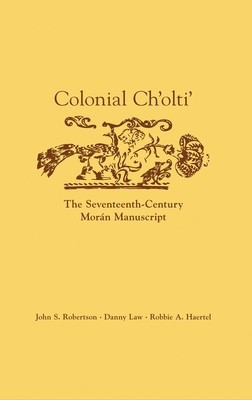
- We will send in 10–14 business days.
- Author: John S Robertson
- Publisher: University of Oklahoma Press
- ISBN-10: 0806141182
- ISBN-13: 9780806141183
- Format: 18 x 25.4 x 3.3 cm, hardcover
- Language: English
- SAVE -10% with code: EXTRA
Reviews
Description
At the time of the Spanish conquest, Ch'olti' was spoken throughout much of the southern Maya lowlands in what is present-day Petén and Chiquimula, and is closely related to that spoken by the authors of the Classic Maya inscriptions. This book presents for the first time a facsimile, transcription, English and Spanish translation, and grammatical analysis of the Morán Manuscript, a Colonial-era document that provides the sole attestation of Ch'olti'.
In addition to its value as a chronicle of the Colonial period, the Morán Manuscript is crucial to our understanding of the Classic Maya, particularly their language, captured in thousands of intricately carved and painted hieroglyphic inscriptions. Robertson, Law, and Haertel, regarded as the ablest interpreters of Ch'olti' now working in Mayan linguistics, provide not only a painstaking presentation of language data but also a detailed history of the manuscript itself. They discuss the document's probable authorship, investigate where and by whom Ch'olti' was spoken at contact, and infer how speakers maintained their expressive capabilities in the face of colonial oppression. The transcribed Ch'olti' texts feature an orthographically standardized version with a morpheme-by-morpheme gloss, a literal English translation that preserves many of the poetic structures and metaphors, and a flowing translation in both English and Spanish.
The publication of this document marks a major contribution to the fields of Maya epigraphy, Mayan linguistics, ethnohistory, and Mesoamerican languages. It will serve as the definitive presentation of the Morán Manuscript and stand as a major contribution to further understanding the language of the Maya inscriptions in Mexico and Guatemala.
EXTRA 10 % discount with code: EXTRA
The promotion ends in 17d.14:43:00
The discount code is valid when purchasing from 10 €. Discounts do not stack.
- Author: John S Robertson
- Publisher: University of Oklahoma Press
- ISBN-10: 0806141182
- ISBN-13: 9780806141183
- Format: 18 x 25.4 x 3.3 cm, hardcover
- Language: English English
At the time of the Spanish conquest, Ch'olti' was spoken throughout much of the southern Maya lowlands in what is present-day Petén and Chiquimula, and is closely related to that spoken by the authors of the Classic Maya inscriptions. This book presents for the first time a facsimile, transcription, English and Spanish translation, and grammatical analysis of the Morán Manuscript, a Colonial-era document that provides the sole attestation of Ch'olti'.
In addition to its value as a chronicle of the Colonial period, the Morán Manuscript is crucial to our understanding of the Classic Maya, particularly their language, captured in thousands of intricately carved and painted hieroglyphic inscriptions. Robertson, Law, and Haertel, regarded as the ablest interpreters of Ch'olti' now working in Mayan linguistics, provide not only a painstaking presentation of language data but also a detailed history of the manuscript itself. They discuss the document's probable authorship, investigate where and by whom Ch'olti' was spoken at contact, and infer how speakers maintained their expressive capabilities in the face of colonial oppression. The transcribed Ch'olti' texts feature an orthographically standardized version with a morpheme-by-morpheme gloss, a literal English translation that preserves many of the poetic structures and metaphors, and a flowing translation in both English and Spanish.
The publication of this document marks a major contribution to the fields of Maya epigraphy, Mayan linguistics, ethnohistory, and Mesoamerican languages. It will serve as the definitive presentation of the Morán Manuscript and stand as a major contribution to further understanding the language of the Maya inscriptions in Mexico and Guatemala.


Reviews